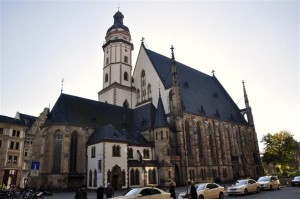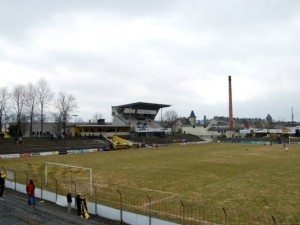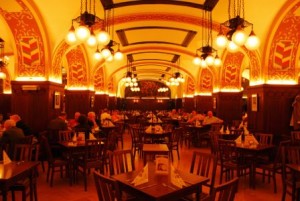
Leipzig & Meissen
On the penultimate day in the region of Saxony we were to visit Leipzig, the city of music, also known as the city of Johann Sebastian Bach who lived and worked in Leipzig for over 27 years and later was buried in St. Thomas’ Church. On our schedule for the day, was also a visit to the city of “white gold” or European Porcelain – Meissen.

Leipzig is historical as it was the first town in Germany to win the right from the Emperor to hold a trade fair, way back in 1497 and it grew over the years to become a cosmopolitan and commercial hub and one of the most important cities of Germany. Leipzig is close to Berlin and not too far from Frankfurt on Main. It was the largest trading town and has a tradition as a trade fair city. The Leipzig Fair organized in the city is in fact the oldest trade fair in the world and at times is referred to as the “Mother of all Fairs”. Leipzig was undoubtedly the most famous trade fair town of Germany until WW II. After the Second World War, and after the reunification, it was Frankfurt which gained prominence as the city of the Trade Fairs.

Leipzig has the biggest train station in Germany as it was a trade fair town and a visit to it is a must when visiting Leipzig. The largest shopping mall is in the Leipzig Main Station. It is a city known for its automobiles, industries and technology. The Porsche Cayenne is produced here and also the 3 Series of the BMW. Global players like DHL, Amazon and Siemens have their headquarters in Leipzig.

Leipzig is a city of music with well known names such as Bach, Mendelssohn and Wagner.It also has the second oldest University after Heidelberg and over 50000 students come every year to study in Leipzig. Interestingly, the Berlin Wall came down because of Leipzig as it was within the walls of the St. Nicholas Church that there was a non-violent protest movement that took place in 1989 and led to the fall of the Berlin Wall and the reunification of Germany.

During our short visit to Leipzig, we did a walking tour of the city following the traces of some of the well known musicians, the churches of St. Thomas and St. Nicholas and the tomb of Bach. The Nikolaikirche, or the St. Nicholas Church is the oldest church in Leipzig, dating back to 1165 and refurbished in the 18th Century. The date of 9th October 1989 has a great significance as it was the day that lead to the breakdown of the German Democratic Republic and reunification of Germany.
Nearby we also had the opportunity to see the tomb of Johann Sebastian Bach.

In the past Leipzig was a small town and the major developments took place here only after the 20th Century. Leipzig is a city which is a delight for fans of classical music as you have the Bach museum, Schumann’s House and Mendelssohn’s House which is unparalleled anywhere in the world.
For lovers of coffee, a visit to the Zum Arabischen Coffee Baum,one of the oldest coffee houses in Germany, is a must. Here you can have some coffee and then go upstairs to see the coffee museum. Amongst their guests were Wagner, Schumann and other famous personalities.
A very historical place – the Auerbachs Keller (or Auerbach’s Cellar in English), is a remarkable restaurant in the most beautiful shopping arcade, the Mädler Passage. Approximately 75000 litres of beer are consumed in the cellar every year. The Auerbachs Keller ranks amongst the top 10 most well known restaurants in the world dating back to 1525.

The most interesting part of the cellar are the wine rooms where gourmet cuisine is served. The Goethe Room, The Luther Room and Alt Leipzig and Fasskeller are places where the historians frequented during the earlier days and in the big cellar of Grosse Keller is where you can experience fine Saxonian hospitality with 100 years of tradition. The big cellar offers a romantic and personal ambience and has a capacity of seating 500 guests. A visit to the Auerbachs Keller was truly a cultural, historic and culinary discovery, very unique and special.

Thereafter we headed to Meissen, also known as the Cradle of Saxony and the former capital of this region which is a 40 minute drive northwest of Dresden. Although European porcelain was invented in Dresden, it was here in Meissen where the porcelain became world famous and later we were not only to visit the State Porcelain Manufactory but to have some fine cuisine served in Meissen porcelain at the Manufactory. Our visit to Meissen commenced with a walking tour of the old town and it is here that the German Emperor established his rule by erecting a castle on the hill during the 10th Century. Meissen is also on the Saxon wine trail route as it is one of Germany’s smallest wine growing regions.

Meissen is rich in history and the mighty ensemble of Albrechtsburg Castle and Meissen Cathedral adds character to this beautiful town. The Albrechtsburg Castle was the first castle ever designed as a royal residence in the German speaking region and was built in Gothic style during the 15th Century. Now a museum, it is truly an architectural masterpiece. A visit to the Vincenz Richter wine bar is a must. The Vincenz Richter is one of the most famous wine restaurants and is like a museum. This former guildhouse dating back to 1523 lies on the main marketplace and is family owned since 1873. The restaurant has a fine antique collection of pictures and weapons on display including a room with instruments of torture dating back to the Middle Ages. The torture chamber as it is known can be visited by the guests of the restaurant and is quite interesting indeed.
On our way across the medieval narrow streets we came across a shop selling Meissen Fummel, a fine pastry with a protected designation of origin from Meissen. The shape is an irregular round “balloon” made of very thin dough and the pastry is very brittle and fragile.

Our final halt was at the Meissen porcelain manufactory. The “crossed swords” are one of the oldest trade marks in the world and epitomizes accomplished craftsmanship, beauty and style. Each piece of Meissen porcelain is an original handmade work of artists which makes the porcelain truly a collector’s item.We were taken through the various stages of how porcelain is shaped and the time taken to make it a finished product does make it truly the “white gold”. It is said that Johann Friedrich Böttger was supposed to make gold for the Elector of Saxony, Augustus the Strong and accidentally ended up developing red stoneware which eventually became the white gold or the European porcelain.
And then we were all set for the grand finale of the Saxony trip… the dinner ceremony on Meissen porcelain. Saxony is the gastronomic capital of Germany.
The following day I took my flight home and when I made my second trip to Germany in less than a year, I planned an itinerary covering the regions of Hessen, Baden Württemberg and Bavaria starting with the magical city of Frankfurt.




